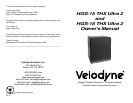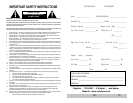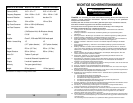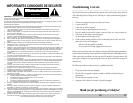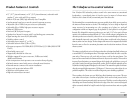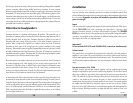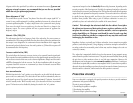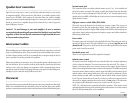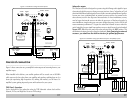
3
☞
Important!!!
Do not use both LINE LEVEL and SPEAKER LEVEL connections simultaneously!
Volume control
This control allows you to balance the output from the subwoofer to the main speakers/
amplifier in your system. This control should be set to achieve similar output level from
both the main speakers and subwoofer when listening to music. The remote may then be
used for minute/temporary adjustments, such as increasing the volume for home theater
usage.
Low-pass crossover- 40 to 120Hz
All inputs sum the left and right channels together, with the resulting signal passing
through an adjustable low-pass crossover before being amplified. The crossover control
allows you to adjust the upper limit of the subwoofer's frequency response from 40 to
120Hz. The subwoofer's response will begin rolling off above the frequency you set this
control to. You should set the crossover frequency to obtain a smooth and seamless
transition from the subwoofer to the main speakers in your system. If your main speakers
are smaller units with limited low frequency output, you may wish to choose a higher
frequency (such as 100-120Hz) than you would with larger speakers which have greater low
frequency output. With larger speakers, you might start with this control set lower, such
as 80Hz.
10
The first type of protection circuitry which prevents overdriving of the speaker or amplifier
operates constantly without being audible under most situations. In some extreme
situations (sustained high output levels such as pro sound usage), the unit may shut down
momentarily. The blue power led may also blink rapidly. This indicates operation of the
thermal or undervoltage protection circuitry. If this should happen, you should reduce the
volume setting or shut the unit off until normal operating conditions return. You may also
want to plug the unit into a different wall outlet, as dropping power line voltage will be most
noticeable under strenuous conditions.
Distortion in loudspeakers
––––––––––––––––––––––––––––––––––––––––––––––––––––––––––––
Nonlinear distortion is a problem which plagues all speakers. This particular type of
distortion is a common problem in subwoofers, which must move large amounts of air to
produce adequate levels of deep bass. Nonlinear distortion is defined as any form of
distortion that moves energy from one portion of the audio frequency spectrum to
another. When a single tone is applied to a nonlinear system, the result is harmonic
distortion. In which some of the energy leaves the system at multiples of the original
frequency. When multiple tones are applied, intermodulation tones are produced, usually
as simple combinations of the input frequencies. Generally, 3% distortion is considered a
reasonable amount for speakers. This means that 3% of the total energy leaving the speaker
is at frequencies other than the intended input signal.
Most subwoofers on the market today however, produce much more than 3% distortion
at common listening levels. Many models we have tested produce greater than 20%
distortion @ 20Hz when driven to 100dB. This is a typical output level obtained in many
systems, particularly home theater systems. Even at 1 watt, many conventional units
produce several percent distortion. Secondly, the odd order, higher harmonics are much
more offensive to the human ear than the closer 2nd harmonic.
An interesting result of this reduced distortion is that some of the bass, when played over
an extremely accurate subwoofer system, seems to actually be missing. The truth, however,
is that the "missing" bass was never there to begin with! Distortion products of conventional
woofers actually add to the bass spectrum making it appear louder than recorded. This is
due to the additional and unwanted harmonics (distortion) of the fundamental signal.
While conventional subwoofers offer little to combat distortion products, we at Velodyne
have developed another way. . .
continued. . .
☞
Installation
——————————————————————————————————————————————
Your new Velodyne servo subwoofer provides for a number of installation options. Read
all the installation information below in order to determine which installation option is best
for your system. Remember to perform all installation procedures with system
power turned off!!!
Inputs
Your new subwoofer is equipped with speaker-level, line-level and balanced (XLR) inputs.
Use the LINE LEVEL jacks when connecting your subwoofer to a pre-amp, signal
processor, line-level crossover, or receiver with pre-amp level outputs. The SPEAKER
LEVEL jacks connect directly to the speaker outputs of any amplifier, integrated amplifier
or receiver. Your amplifier section will notice no additional loading effects when you use
these inputs due to their very high impedance.



